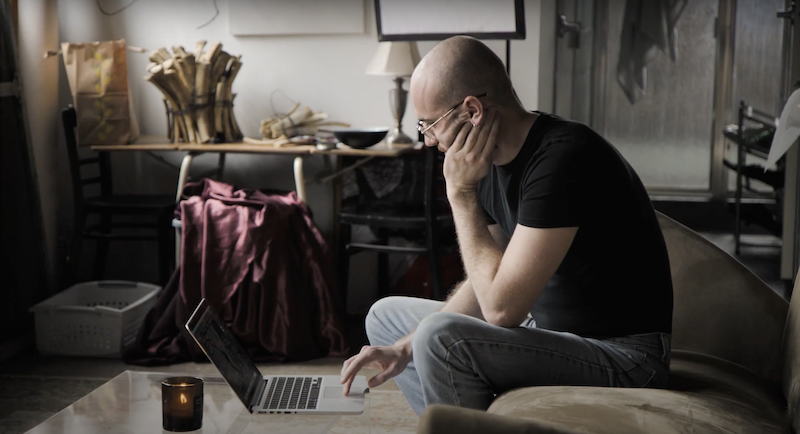Trustfall
First-time visitors to the Harrison Center often get lost in the building. Sometimes they wander into my studio, assuming it connects to somewhere else they are trying to go. The sign outside my stairwell reads “more art upstairs,” and for many people, that’s all the direction they need—they walk up the stairs, and before they know it, they have stepped through my front door. I live in my studio, and this quickly becomes apparent to them when they’re met with a refrigerator, a bed, and a couch. The look on their face always reads, “Who’s house have I stumbled into and how quickly can I get out of here?” But this doesn’t bother me too much; it's just part of the gig. I try to make it worth their time, introducing them to my work covering the walls: photographs, mixed media experiments of goose feathers, glass, string, collage, etc.
Smith working in studio
On May’s first Friday, the usual crowd of slightly confused strangers walked into my studio, but this time they were met with a backdrop and a strobe light pointed at an empty chair. I asked each one if they would let me take their picture and, if so, would they prefer to face the camera or turn their backs to me. Most of them agreed. I anticipated that the majority of my subjects would feel more comfortable turned away, especially if they were not in the mood to have their picture taken, but I was wrong. Almost everyone wanted to face the camera. One person even told me he was excited to show off his smile but was quickly disappointed when I asked him to give me his best deadpan expression. “Pretend like you’re at the DMV,” I said.
We are used to looking at a camera and immediately putting on our best selves. We even do a little dance: posing and showing off our faces in the ways in which we are most comfortable. It’s amazing to tap into people’s preconceived notions about what to expect from photography. One person admitted that he never had his picture taken in this way; instead, it was always for some sort of understood purpose—always with the subtext that he knew where the picture would go and what it would be used for. No one seemed to understand the purpose of what I was doing, which was a bizarre feeling to them. Soon I began to realize that so few wanted to turn their backs to me because it felt vulnerable, like the way a wild animal would hesitate to turn its back to you in fear that you might pounce.
Photography is a social practice. It requires you to have an encounter, in some way, with your surroundings. In the current age, we are swimming in images—perhaps too many—yet even avenues like social media have taught us some powerful lessons about photography: like, the fact that it is a total facade. It always has been. Even back at its formation, the darkroom was a place where imagination ran wild. Artists would seamlessly piece together multiple photographs to create surreal hybrid images. Photography is given too much credit for accurately depicting our world. It will always be a mysterious medium: one part truth and the other part fantasy.
I often think about artificial intelligence’s ability to create summations of faces from across the web. By adding your face to the mix, you participate in a massive visual archive of humanity, helping to train AI and other rapidly advancing technologies for purposes that are yet to be determined. How does this make you feel? If I were to ask you to pose for this project, would you face the camera and allow yourself to become a part of the broad world of images? Will you gladly accept such a mysterious fate or turn away from the camera, protecting yourself from the unknown?
David Lynch’s 2006 film Inland Empire opens with a girl in a bedroom, watching tv with tears in her eyes. On the television screen is a sitcom of people dressed in rabbit costumes. The scene is foreboding, confusing, and borderline scary, but when I first watched it, I began to get teary-eyed myself—I really have no idea why. We can’t always put language around the ways in which images and media affect us, but there is something beautiful about entrusting an artist to take us somewhere, even if we don’t know where we’re going. Trust is precious, and in an age of artifice and manipulation, nearly unimaginable. So, all things considered, I’ll take whatever trust I can get.
Caleb John Smith is an artist at the Harrison Center and is currently completing an administrative fellowship. Read more of his writing here.






